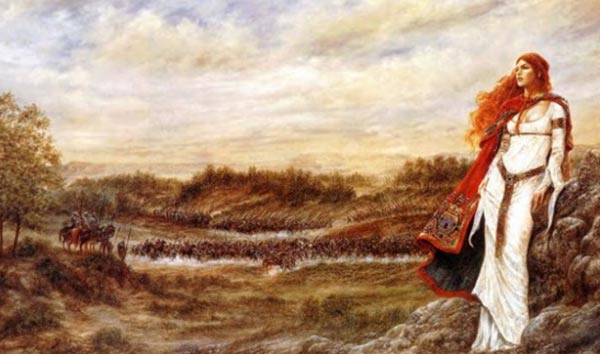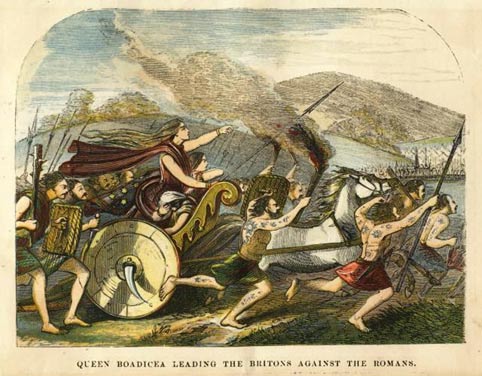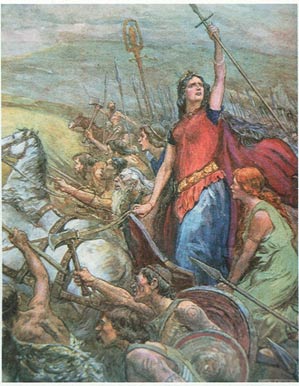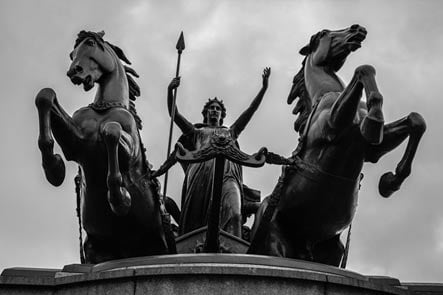(Also Read Part 1 )
Queen Boudicca had every reason to hate the Romans – by 60 AD, the lands of the Iceni clan of Britain had been captured, her people had been killed or taken as slaves, she was publicly beaten and her daughters raped – but Boudicca, the Celtic warrior queen, would eventually leave the Romans quaking in their boots, at least for a time.
After the brutal attack on her daughters, Boudicca immediately began summoning her people for revolt. While the Romans were busy fighting the Druids, who had raised the native population and their leaders against the Romans in the west of Britain and North Wales, Boudicca spotted her chance for revenge.
Boudicca met with the leaders of the Iceni, Trinovanti, Cornovii, Durotiges, and other tribes, who also had grievances against the Romans, including the imposition of heavy taxes, grants that had been redefined as loans, the taking over of land, and Roman attempts to suppress Celtic religious practices. They planned to revolt and drive out the Romans, and Boudicca was chosen as their leader.
Roman senator and historian, Tacitus (56 – 117 AD), describes Boudicca exhorting troops from her chariot, her daughters beside her. She presented herself, not as a queen and an aristocrat avenging her lost wealth, but as an ordinary person and a mother, who was seeking revenge for her lost freedom, her battered body and soul, and the defilement of her daughters. She told her people, and those belonging to allied tribes, that their cause was just and the deities were on their side.
Roman historian, Cassius Dio (155 – 235 AD), wrote that Boudicca employed a form of divination, releasing a hare from the folds of her dress to interpret the direction in which it ran, and invoked Andraste, a British goddess of victory. He also described her appearance as she stood before her crowds of followers:
“In stature she was very tall, in appearance most terrifying, in the glance of her eye most fierce, and her voice was harsh; a great mass of the tawniest hair fell to her hips; around her neck was a large golden necklace; and she wore a tunic of diverse colors over which a thick mantle was fastened with a brooch.”
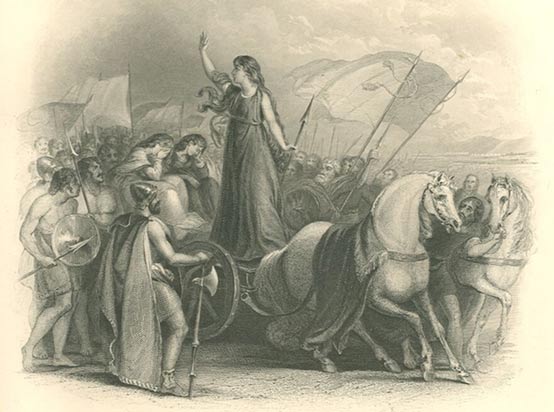 Queen Boudicca summoned troops from her chariot, her daughters by her side. Image source .
Queen Boudicca summoned troops from her chariot, her daughters by her side. Image source .
Historical records suggest that Boudicca succeeded in gathering an army of up to 100,000 warriors. Her first target was Camulodunum (now modern-day Colchester), a town for discharged Roman soldiers and the site of a temple to the former Roman Emperor Claudius. The Iceni and their allies descended upon the town, and razed it to the ground. They leveled the houses, broke the Roman statues and tombstones, and burnt the entire settlement. They took no prisoners; every Roman citizen in the city was killed.
Upon hearing the news of the revolt, the Roman Governor Gaius Suetonius Paulinus hurried to Londinium (modern London), the twenty-year-old commercial settlement that was the Britons’ next target. But the Romans, having concluded that they did not have the numbers to defend the settlement, evacuated and abandoned the town. Boudicca’s warriors burned and destroyed the entire settlement, killing anyone that had not been sensible enough to leave. There were no survivors.
Boudicca’s third and final annihilation was at Verulamium (now known as St Albans), which again was raised to the ground and completely destroyed. By the end of the final attack, an estimated 70,000 – 80,000 had been killed. The crisis caused the Emperor Nero to consider withdrawing all Roman forces from Britain. Boudicca believed her destruction of three key city’s would free Britain of the Roman’s, but she was sadly mistaken.
Boudicca led her people in a revolt against the Romans in Camulodunum, Londinium, and Verulamium. Image source.
Romans rally
After Boudicca’s attack on Verulamium, Suetonius quickly regrouped his forces in the West Midlands. Boudicca’s army had counted on seizing Roman food stores when the tribes abandoned their own fields to wage rebellion, but Suetonius had strategically seen to the burning of the Roman stores, and the lack of supplies weakened her forces.
Boudicca and her people fought one more battle, but it was not to be a victory. The precise location of this battle is unknown but it is believed to have taken place somewhere along the Roman road now known as Watling Street in the West Midlands.
The Britons came to face-to-face with the Romans, their numbers vastly outnumbering their opponents. What should have been an overwhelming victory, was one of disaster – Boudicca’s army had to attack uphill, and exhausted and hungry, the Romans quickly gained the upper hand. The lack of maneuverability of the Britons, caused by the narrowness of the field in which they fought, put them at a disadvantage to the Romans, who were skilled at open combat due to their superior equipment and discipline.
Boudicca’s people had no choices but to retreat. However, they had been so certain of victory that they had asked their families to come along and watch from wagons surrounding the field. This was a big mistake, as the wagons now barred their escape route, and some 80,000 warriors and their spectators were killed. According to Tacitus, only 400 Romans died in the battle that day – although the accuracy of these numbers have been drawn into question.
In revenge, the Romans executed the Iceni and their allies or made them slaves. Their lands were taken over by the military, families lost their hereditary homelands and the great rebellion was over. The final result was that the Romans strengthened their military presence in Britain – they were there to stay.
Boudicca led her people in one last battle, but it was not to be their victory. Image source.
It is not known exactly what happened to Boudicca after the war. Some people suggest that she escaped with her daughters to another part of Britain, where they drank from a poisoned chalice and died. Cassius Dio wrote that she fell sick and died and was given a lavish burial; though this may have just been a convenient way to remove her from the story.
Either way, it seems that Boudicca and her daughters were saved from a fate worse than death. Had they been captured, the Romans would have made them walk in a victory parade before torturing them and displaying their bodies to cheering crowds. The whereabouts of their bodies is also shrouded in mystery. Some people believe that Boudicca was buried at Stonehenge while others suggest Norfolk, Hampstead in north London or under a platform belonging to London’s Kings Cross Station.
Boudicca’s legacy
Boudicca’s story was nearly lost to the pages of history, until Tacitus’ work, Annals, was rediscovered in 1360. This led to a surge of interest in Boudicca and her relentless campaign to free her people from Roman rule. It was in the Victorian era that Boudicca’s fame took on legendary proportions as Queen Victoria came to be seen as Boudica’s namesake, their names being identical in meaning. Victoria’s Poet Laureate, Alfred, Lord Tennyson, wrote a poem, “Boadicea”, and several ships were named after her.
Boudicca has since remained an important cultural symbol in the United Kingdom. A great bronze statue of Boudicca with her daughters in her war chariot was commissioned by Prince Albert and executed by Thomas Thornycroft. It was completed in 1905 and now stands next to Westminster Bridge and the Houses of Parliament, positioned in the city that she had once razed to the ground in her quest for freedom.
The statue of Boudicca, Queen of the Iceni, which now stands next to the Houses of Parliament in London. Credit: captainslack / deviantart
Top image: Artist’s depiction of Queen Boudicca. Image source.
–
(For the source of this, and many other equally intriguing articles, please visit: https://www.ancient-origins.net/history-famous-people/boudicca-celtic-queen-unleashed-fury-romans-part-2-002067/)









